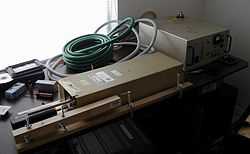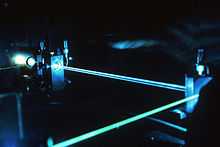Ion laser

An ion laser is a gas laser which uses an ionized gas as its lasing medium.[1] Like other gas lasers, ion lasers feature a sealed cavity containing the laser medium and mirrors forming a Fabry–Pérot resonator. Unlike HeNe lasers, the energy level transitions that contribute to laser action come from ions. Because of the large amount of energy required to excite the ionic transitions used in ion lasers, the required current is much greater, and as a result all but the smallest ion lasers are water-cooled. A small air-cooled ion laser might produce, for example, 130 mW of light with a tube current of 10A @ 105V. This is a total power draw over 1 kW, which translates into a large amount of heat which must be dissipated.
Types
Krypton laser
A krypton laser is an ion laser, a type of gas laser using krypton ions as a gain medium, pumped by electric discharge. Krypton lasers are used for scientific research, or when krypton is mixed with argon, for creation of "white-light" lasers, useful for laser light shows. Krypton lasers are also used in medicine (e.g. for coagulation of retina), for manufacture of security holograms, and numerous other purposes.
Krypton lasers emit at several wavelengths through the visible spectrum: at 406.7 nm, 413.1 nm, 415.4 nm, 468.0 nm, 476.2 nm, 482.5 nm, 520.8 nm, 530.9 nm, 568.2 nm, 647.1 nm, 676.4 nm.
Argon laser

The Argon Ion laser was invented in 1964 by William Bridges at Hughes Aircraft [2] and is one of a family of Ion lasers that use a noble gas as the active medium.
Argon ion lasers are used for retinal phototherapy (for diabetes), lithography, and pumping other lasers. Argon ion lasers emit at 13 wavelengths through the visible, ultraviolet, and near-visible spectrum, including: 351.1 nm, 363.8 nm, 454.6 nm, 457.9 nm, 465.8 nm, 476.5 nm, 488.0 nm, 496.5 nm, 501.7 nm, 514.5 nm, 528.7 nm, 1092.3 nm.[3]

Common argon and krypton lasers are capable of emitting continuous wave output of several milliwatts to tens of watts. Their tubes are usually made of Nickel end bells, kovar metal to ceramic seals, beryllium oxide ceramics, or tungsten disks mounted on a copper heat spreader in a ceramic liner. The earliest tubes were simple quartz, followed by quartz with graphite disks. In comparison with the helium–neon lasers requiring just a few milliamps, the current used for pumping the krypton laser ranges in several amperes, as the gas has to be ionized. The ion laser tube produces a lot of waste heat and requires active cooling.
The typical noble gas ion laser plasma consists of a high-current-density glow discharge in a noble gas, in the presence of a magnetic field. Typical CW plasma conditions are current densities of 100 to 2000 A/cm^2, tube diameters of 1 to 10 mm, filling pressures of 0.1 to 1.0 torr, and an axial magnetic field of the order of 1000 G. (Bridges,Halstead et al., Proceedings of the IEEE, 59 (5). pp. 724–739)
William R. Bennett was co-inventor of the first gas laser (the helium–neon laser), was first to observe spectral hole burning effects in gas lasers, and created a theory of hole burning effects on laser oscillation. He was co-discoverer of lasers using electron impact excitation in each of the noble gases, dissociative excitation transfer in the neon-oxygen laser (the first chemical laser), and collision excitation in several metal vapor lasers.
Other commercially available types
- Ar/Kr: A mix of argon and krypton can result in a laser with output wavelengths that appear as white light.
- Helium Cadmium, Blue laser emission at 442 nm and Ultraviolet at 325 nm
- Copper Vapor, Yellow and Green emission at 578 nm and 510 nm
Experimental
Power supplies
- NPN passbank like the Spectra-physics 270 supply
- MOSFET switchers like the Omnichrome 150 supply
- Early switchers used NPN_PNP Pairs, (i.e. American Laser or HGM Medical)
- IGBT will be seen more in days to come
- Switched resistor (Spectra Physics)
- Non-switched resistor (Home-made, typically a water heater element)
- Water-cooled resistor (Laser Ionics etc.)
- Phased SCR power supplies similar to long xenon arc lamps are used in medical lasers to reduce expense (Coherent)
- Power on Demand power supplies are used for pulsed medical ion laser systems, these power supplies consist of a large capacitor bank charged by a switching supply to enable multi watt lasers to run off common single phase power supplies in doctor's offices.
- A typical air-cooled Argon Tube needs an equivalent series resistance of ~6 Ohms when running @ 10 amps off 117V power. The plasma in an ion laser, unlike a Helium Neon Laser, has a slightly positive resistance, but will still run away without ballasting. This is why ion laser supplies are very difficult to design. On a large frame laser, the plasma itself has an effective resistance of about -7 Ohms (Spectra Physics 171 Service Manual)
Applications
- Surgical.
- Laser medicine.
- High speed typesetters.
- Laser light shows.
- DNA sequencers.
- Spectroscopy experiments.
- Pumping dye lasers.[7]
- Semiconductor wafer inspection.
- Direct write high density PCB lithography.
- Fiber Bragg Grating production.
- Long coherence length models can be used for holography.
See also
References
- ↑ IUPAC, Compendium of Chemical Terminology, 2nd ed. (the "Gold Book") (1997). Online corrected version: (2006–) "ion laser".
- ↑ W. B. Bridges, "LASER OSCILLATION IN SINGLY IONIZED ARGON IN THE VISIBLE SPECTRUM", Appl. Phys. Lett. 4, 128-130 (1964).
- ↑ http://www.lexellaser.com/techinfo_gas-ion.htm
- ↑ Hoffman Toschek, et al., "The Pulsed Xenon Ion Laser: Covers the UV, visible, and near-IR with optics changes", IEEE Journal of Quantum Electronics
- ↑ Hattori, Kano, Tokutome and Collins, "CW Iodine Ion Laser in a Positive Column Discharge", IEEE Journal of Quantum Electronics, June 1974
- ↑ Cold Cathode Pulsed Gas Laser" by R. K. Lomnes and J. C. W. Taylor in: Review of Scientific Instruments, vol 42, no. 6, June, 1971.
- ↑ F. J. Duarte and L. W. Hillman (Eds.), Dye Laser Principles (Academic, New York, 1990) Chapters 3 and 5.